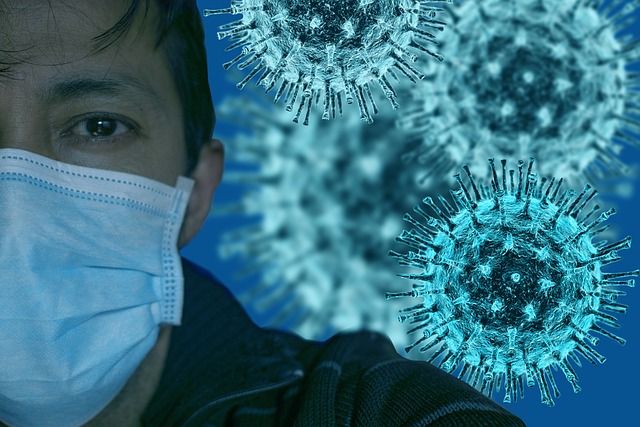Summary Face masks do not completely prevent the transmission of respiratory infections, but masked people are likely to inhale fewer infectious particles. If smaller infectious doses tend to produce milder infections but ultimately induce similar levels of immunity, then masking could reduce the prevalence of severe disease even if the total number of infections is not affected. It has been suggested that this masking effect is analogous to the practice of variolation prior to smallpox vaccination, in which susceptible individuals were intentionally infected with small doses of live virus (and often acquired immunity without severe disease). We present a simple epidemiological model in which mask-induced variolation causes milder infections, potentially with a lower transmission rate and/or different duration. We obtain relationships between the effectiveness of mask-induced variolation and important epidemiological metrics (the basic reproduction number and the initial epidemic growth rate, and the peak prevalence, attack rate, and equilibrium prevalence of severe infections). We illustrate our results using parameter estimates for the original SARS-CoV-2 wild-type virus, as well as the Alpha, Delta, and Omicron variants. Our results suggest that if variolation is a genuine side effect of mask wearing, the importance of face masks as a tool to reduce the healthcare burdens of COVID-19 may be underestimated. |
Comments
McMaster University researchers studying the dynamics of infectious disease transmission have investigated the population-level consequences of a potentially significant, and non-obvious, benefit of wearing masks.
For the study, researchers developed a model to investigate "variolation" of COVID-19, a form of incidental but potentially beneficial immunization achieved by inhaling smaller doses of the virus than would be inhaled without a mask.
In the 18th century, a form of variolization was deliberately used to control smallpox. It involved infecting a healthy individual with small doses of the live virus taken from a dried scab or pustule of a person infected with smallpox. Variolated individuals often experienced much less severe disease than those who became infected naturally, but were nevertheless immune to further infection.
Early in the COVID-19 pandemic, it was suggested that people who became infected while masked might experience mild illness and could be considered "variolated . "
The new mathematical model allows researchers to estimate the potential impact of this effect on the population as a whole.
“If the effect of variolation is strong, then the number of severe cases and consequently the pressure on health care systems could be substantially reduced if most people wear masks, even if the masks do not prevent become infected,” says David Earn, Faculty of Science Research Chair in Mathematical Epidemiology and Professor of Mathematics at McMaster and Global Nexus for Pandemics & Biological Threats in Canada.
The model suggests that effective masking could dramatically slow the spread of COVID-19, reduce the magnitude of the pandemic peak by “flattening the curve,” and reduce the prevalence of severe cases thereafter.
"Our qualitative findings are that the value of mask-wearing is underestimated in a public health context, especially as COVID-19 moves from pandemic to endemic, and we should think twice before getting rid of mask mandates." wearing masks," says Zachary Levine, lead author of the study and former undergraduate student in the Arts and Sciences program at McMaster. Levine is now a graduate student at the Weizmann Institute of Science in Israel.
“As we prepare for the next pandemic, understanding how different infection control strategies could affect disease dynamics could help us understand which policies are worth pursuing.”
The results of this research are potentially applicable to any respiratory infection that is transmitted by inhalation of infectious particles. For future variants of COVID or other infectious diseases, the model can be used to study how increasing the proportion of mild cases affects the overall dynamics of disease spread.
“If wearing a mask protects you in addition to those in the room around you, it could also have a significant impact on everyone not in the room,” Levine says.
Conclusion Beyond qualitative conclusions, it is unlikely that we can make more powerful inferences without experimental studies that convincingly quantify the magnitudes of the effects that induce masking variolization. If such experimental data are available and support the hypothesis that masking induces a substantial variation effect, then it will be worthwhile to expand our simple model (3.1) to include explicit latency periods, hospitalization, age, and social structure (e.g., schools , workplaces) and heterogeneities in adherence to masking and other control measures. With appropriate data and more realistic models, we can make quantitative inferences that could usefully inform policy decisions. In the context of the highly transmissible Delta and Omicron variants, and the potential evolution of new SARS-CoV-2 variants that are even more transmissible and/or more successfully evade existing vaccines, a better understanding of the effectiveness of masking for promoting variolation could be of great value. At the time of writing, vaccines for children under 5 years of age are not yet approved, but are expected to be approved soon. While the availability of vaccines for people of all ages is imperative, substantial vaccine hesitancy and progressive infections among those vaccinated make achieving herd immunity through vaccination a currently unattainable goal. If that situation persists, potential mask-induced variolation could contribute to the control of COVID-19 as we transition to endemicity. |
The study was published online in the Journal of the Royal Society Interface .
















